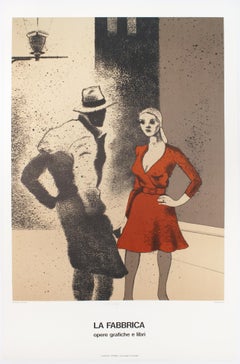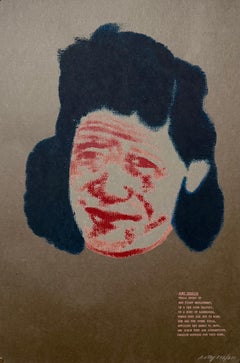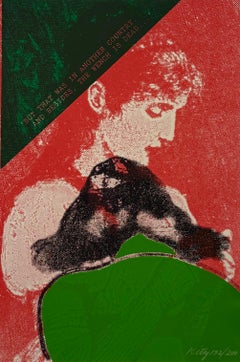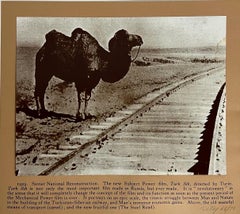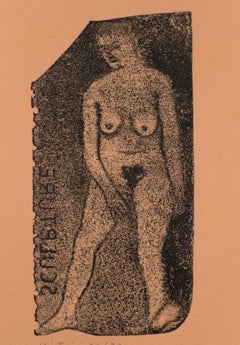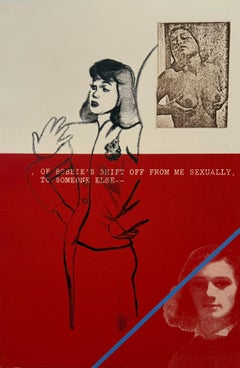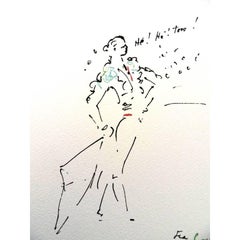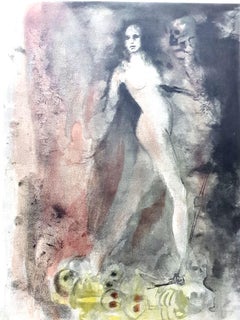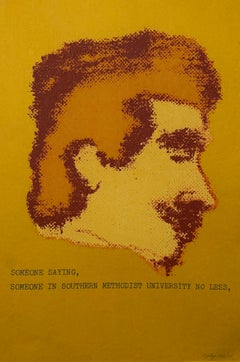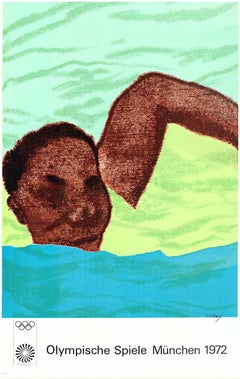Ronald Brooks Kitaj Figurative Prints
American, 1932-2007
Born in Cleveland, Ohio in 1932, R.B. (Ronald Brooks) Kitaj is considered a key figure in European and American contemporary painting. While his work has been considered controversial, he is regarded as a master draftsman with a commitment to figurative art. His highly personal paintings and drawings reflect his deep interest in history; cultural, social and political ideologies; and issues of identity.
Among his various honors are election to the American Academy of Arts and Letters in 1982, and election to the Royal Academy in 1985 (the first American since John Singer Sargent to receive this honor.)
Numerous retrospective exhibitions of his work include shows at the Hirshhorn Museum in Washington, D.C.; The Jewish Museum, Berlin; The Jewish Museum, London; and the Hamburger Kunsthalle in Germany.
Raised in Cleveland, Ohio, and Troy, New York, Kitaj joined the Merchant Marines in 1949.
In 1950, between sailings, he attended classes at the Cooper Union for the Advancement of Science and Art in New York. He went on to study drawing at the Academy of Fine Art in Vienna, Austria.
Kitaj moved to Oxford, England in 1957, and enrolled at The Ruskin School of Drawing and Fine Art, University of Oxford.
In 1959, Kitaj was accepted into Royal College of Art, London, where he befriended classmate David Hockney. Upon graduation from the RCA, Kitaj signed with Marlborough Fine Art, London, where he had his first solo exhibition in 1963. His art career began in earnest, and he found critical acclaim alongside commercial success.
A second solo show followed at Marlborough Gallery, New York, in 1965, and he sold “The Ohio Gang” to The Museum of Modern Art.
In 1969, Kitaj taught for a year at the University of California, Los Angeles.
In 1976, he coined the term “School of London” in an essay he wrote as curator of the polemical exhibition, “The Human Clay,” at the Hayward Gallery, London. The term, though loose, continues to define a group of stylistically diverse artists, including Kitaj, who were working in London at that time focusing on figural representation.
In 1981, he spent a year in Paris, France, where he focused on drawing and use of pastel.
In 1994, the Tate Gallery, London, organized a major retrospective of Kitaj’s work. Hostile and personal attacks from some critics led to what Kitaj referred to as the “Tate War.” The exhibition subsequently traveled to the Los Angeles County Museum of Art and the Metropolitan Museum of Art, New York.
Kitaj moved to Los Angeles, California, and continued to exhibit with Marlborough Fine Art and the Marlborough Gallery, New York.
In 2001 the National Gallery London organized a solo exhibition of paintings: “R.B. Kitaj In the Aura of Cezanne and Other Masters.” Kitaj focused on his “late style” in his Yellow Studio in Westwood and died in 2007.
His gift of his archive to the UCLA Library Special Collections was celebrated with exhibitions at the Skirball Cultural Center and UCLA’s Young Research Library.to
1
4
20
3
Overall Width
to
Overall Height
to
20
3
1
42
846
382
380
308
28
2
21
1
24
4
5
4
3
2
2
1
1
1
1
1
1
1
1
1
22
5
1
1
1
27
1
Artist: Ronald Brooks Kitaj
Vintage SIGNED Kitaj Poster, La Fabbrica, Milan (A Life 1975) woman in red dress
By Ronald Brooks Kitaj
Located in New York, NY
Printed in 1975, this poster features the encounter between an alluring woman dressed in red, and a man with his back to the viewer. The light of a streetlamp is beautifully imitated...
Category
Late 20th Century Modern Ronald Brooks Kitaj Figurative Prints
Materials
Lithograph
British Pop Art Artist RB Kitaj Screenprint Day Book Serigraph Silkscreen Signed
By Ronald Brooks Kitaj
Located in Surfside, FL
R.B. Kitaj (British American 1932-2007)
Hand signed and numbered
Screenprint
Measures approximately 24.5 X 16.65 inches
This is from the Robert Creeley daybook. They were done in ...
Category
1970s Pop Art Ronald Brooks Kitaj Figurative Prints
Materials
Screen
British Pop Art Artist RB Kitaj Screenprint Day Book Serigraph Silkscreen Signed
By Ronald Brooks Kitaj
Located in Surfside, FL
R.B. Kitaj (British American 1932-2007)
Hand signed and numbered
Screenprint
Measures approximately 24.5 X 16.65 inches
This is from the Robert Creeley daybook. They were done in ...
Category
1970s Pop Art Ronald Brooks Kitaj Figurative Prints
Materials
Screen
R.B. Kitaj Screenprint Collage Hand Signed British Pop Art Film Still Camel
By Ronald Brooks Kitaj
Located in Surfside, FL
The Most Important Film Ever Made, 1972
Color screen print and collage, from the edition of 70.
15 x 17 in
38.1 x 43.2 cm
Published by the artist with Marlborough Graphics at the Kelpra studio in 1972. This work is also in the collections of TATE London and the Victoria & Albert Museum. the price reflects the fact that there is no backing page.
Stylistically, these are hybrid works, influenced by Pop art and the modernist tradition of the Readymade, a work of art created when a mundane found object is named as an artwork and set in an art context. This avant-garde concept was originally invented by the Dada master Marcel Duchamp early in the twentieth century. In the 1960s it received renewed attention at a time when artistic norms were again being questioned. Reacting to Andy Warhol’s Pop imagery, Kitaj poignantly called his repurposed lithograph and silkscreen book covers “his soup can, his Liz Taylor.” The blatant use of images taken directly from commercial sources situates In Our Time as a precursor of appropriation art. In turning book covers into works of art, Kitaj is offering fragments of a history of knowledge, in which the content of each volume is at once mysterious and absent. Coming from this passionate bibliophile, the series is nothing less than an intellectual self-portrait.
R.B. Kitaj, in full Ronald Brooks Kitaj . Ron Kitaj...
Category
1960s Pop Art Ronald Brooks Kitaj Figurative Prints
Materials
Screen
Nude Sculpture R.B. Kitaj drawing of nude woman on handmade orange paper print
By Ronald Brooks Kitaj
Located in New York, NY
Here Kitaj depicts a sculpture of a nude woman, shaded delicately in black, printed on wonderfully textured handmade muted orange paper. The woman’s hand reaches to the inside of her...
Category
Late 20th Century Modern Ronald Brooks Kitaj Figurative Prints
Materials
Lithograph
British Pop Art Artist RB Kitaj Screenprint Day Book Serigraph Silkscreen Signed
By Ronald Brooks Kitaj
Located in Surfside, FL
R.B. Kitaj (British American 1932-2007)
Hand signed and numbered
Screenprint
This is from the Robert Creeley daybook. They were done in a variety of mixed media including serigraph, ...
Category
1970s Pop Art Ronald Brooks Kitaj Figurative Prints
Materials
Screen
POGANY rare 17 color 1960s British Pop silkscreen signed numbered edition of 70
By Ronald Brooks Kitaj
Located in New York, NY
R.B. Kitaj
POGANY, 1966
17 colour Screenprint and Photo-screenprint
24 × 36 inches
Pencil signed and numbered from the Limited Edition of 70
Hand-signed by artist, Signed & numbered ...
Category
1960s Pop Art Ronald Brooks Kitaj Figurative Prints
Materials
Screen, Pencil
British Pop Art Artist RB Kitaj Screenprint Day Book Serigraph Silkscreen Signed
By Ronald Brooks Kitaj
Located in Surfside, FL
R.B. Kitaj (British American 1932-2007)
Hand signed and numbered
Screenprint
This is from the Robert Creeley daybook. They were done in a variety of mixed media including serigraph, ...
Category
1970s Pop Art Ronald Brooks Kitaj Figurative Prints
Materials
Screen
British Pop Art Artist RB Kitaj Screenprint Day Book Serigraph Silkscreen Signed
By Ronald Brooks Kitaj
Located in Surfside, FL
R.B. Kitaj (British American 1932-2007)
Hand signed and numbered
Screenprint
This is from the Robert Creeley daybook. They were done in a variety of mixed media including serigraph, ...
Category
1970s Pop Art Ronald Brooks Kitaj Figurative Prints
Materials
Screen
Swimmer - Screenprint (Olympic Games Munich 1972)
By Ronald Brooks Kitaj
Located in Paris, IDF
Ronard Brooks KITAJ
Swimmer
Screen print
Signature printed in the plate
On heavy paper 101 x 64 cm (c. 40 x 26 inch)
Made for the Olympic Games in Munich, 1972
Excellent condition
Category
1970s American Modern Ronald Brooks Kitaj Figurative Prints
Materials
Screen
BAGHDAD Six color screenprint, renowned British Pop pioneer R.B. Kitaj, Signed/N
By Ronald Brooks Kitaj
Located in New York, NY
Ronald Brooks (R.B.) Kitaj
BAGHDAD, 1972
Six Color Screenprint and Photoscreenprint
20 × 14 1/2 inches
Pencil signed and numbered 1/125
Printed at Kelpra Studio, London
Published by ...
Category
1970s Pop Art Ronald Brooks Kitaj Figurative Prints
Materials
Screen
British Pop Art Artist RB Kitaj Screen Print on Acetate Serigraph Signed
By Ronald Brooks Kitaj
Located in Surfside, FL
R.B. Kitaj (British American 1932-2007)
Hand signed and numbered
Screenprint
Measures approximately 24.5 X 16.65 inches
This is from the Robert Creeley daybook. They were done in ...
Category
1970s Pop Art Ronald Brooks Kitaj Figurative Prints
Materials
Screen
R.B. Kitaj Orgasm: drawing of woman in ecstasy with pale pink and clay red
By Ronald Brooks Kitaj
Located in New York, NY
Printed in a rich terra cotta red on pale pink paper, Orgasm depicts a woman’s head in profile with a dark background. Kitaj was fascinated with the female form, often producing edgy...
Category
Late 20th Century Realist Ronald Brooks Kitaj Figurative Prints
Materials
Lithograph
British Pop Art Artist RB Kitaj Screenprint Day Book Serigraph Silkscreen Signed
By Ronald Brooks Kitaj
Located in Surfside, FL
R.B. Kitaj (British American 1932-2007)
Hand signed and numbered
Screenprint
Measures approximately 24.5 X 16.65 inches
This is from the Robert Creeley daybook. They were done in ...
Category
1970s Pop Art Ronald Brooks Kitaj Figurative Prints
Materials
Screen
British Pop Art Artist RB Kitaj Screenprint Day Book Serigraph Silkscreen Signed
By Ronald Brooks Kitaj
Located in Surfside, FL
R.B. Kitaj (British American 1932-2007)
Hand signed and numbered
Screenprint
This is from the Robert Creeley daybook. They were done in a variety of mixed media including serigraph, ...
Category
1970s Pop Art Ronald Brooks Kitaj Figurative Prints
Materials
Screen
British Pop Art Artist RB Kitaj Screenprint Day Book Serigraph Silkscreen Signed
By Ronald Brooks Kitaj
Located in Surfside, FL
R.B. Kitaj (British American 1932-2007)
Hand signed and numbered
Screenprint
Measures approximately 24.5 X 16.65 inches
This is from the Robert Creeley daybook. They were done in ...
Category
1970s Pop Art Ronald Brooks Kitaj Figurative Prints
Materials
Screen
British Pop Art Artist RB Kitaj Day Book Mourlot Lithograph Jim Dine Signed
By Ronald Brooks Kitaj
Located in Surfside, FL
R.B. Kitaj (British American 1932-2007)
Hand signed and numbered
Screenprint
This is from the Robert Creeley daybook. They were done in a variety of mixed media including serigraph, ...
Category
1970s Pop Art Ronald Brooks Kitaj Figurative Prints
Materials
Screen
British Pop Art Artist RB Kitaj Screenprint Day Book Serigraph Silkscreen Signed
By Ronald Brooks Kitaj
Located in Surfside, FL
R.B. Kitaj (British American 1932-2007)
Hand signed and numbered
Screenprint
Measures approximately 24.5 X 16.65 inches
This is from the Robert Creeley daybook. They were done in ...
Category
1970s Pop Art Ronald Brooks Kitaj Figurative Prints
Materials
Screen
Dominie in Catalonia, Kitaj drawing black white portrait of young girl with hat
By Ronald Brooks Kitaj
Located in New York, NY
This hand-drawn black and white portrait of Dominie, Kitaj’s adopted daughter, is one of the few etchings produced by the artist. The shape of Dominie’s wide sunhat and its patterned...
Category
Late 20th Century Ronald Brooks Kitaj Figurative Prints
Materials
Etching
British Pop Art Artist RB Kitaj Screenprint Day Book Serigraph Silkscreen Signed
By Ronald Brooks Kitaj
Located in Surfside, FL
R.B. Kitaj (British American 1932-2007)
Hand signed and numbered
Screenprint
Measures approximately 24.5 X 16.65 inches
This is from the Robert Creeley daybook. They were done in ...
Category
1970s Pop Art Ronald Brooks Kitaj Figurative Prints
Materials
Screen
British Pop Art Artist RB Kitaj Screenprint Day Book Serigraph Silkscreen Signed
By Ronald Brooks Kitaj
Located in Surfside, FL
R.B. Kitaj (British American 1932-2007)
Hand signed and numbered
Screenprint
This is from the Robert Creeley daybook. They were done in a variety of mixed media including serigraph, ...
Category
1970s Pop Art Ronald Brooks Kitaj Figurative Prints
Materials
Screen
British Pop Art Artist RB Kitaj Screenprint Day Book Serigraph Silkscreen Signed
By Ronald Brooks Kitaj
Located in Surfside, FL
R.B. Kitaj (British American 1932-2007)
Hand signed and numbered
Screenprint
Measures approximately 24.5 X 16.65 inches
This is from the Robert Creeley daybook. They were done in ...
Category
1970s Pop Art Ronald Brooks Kitaj Figurative Prints
Materials
Screen
British Pop Art Artist RB Kitaj Screenprint Day Book Serigraph Silkscreen Signed
By Ronald Brooks Kitaj
Located in Surfside, FL
R.B. Kitaj (British American 1932-2007)
Hand signed and numbered
Screenprint
Measures approximately 24.5 X 16.65 inches
This is from the Robert Creeley daybook. They were done in ...
Category
1970s Pop Art Ronald Brooks Kitaj Figurative Prints
Materials
Screen
British Pop Art Artist RB Kitaj Screenprint Day Book Serigraph Hand Signed
By Ronald Brooks Kitaj
Located in Surfside, FL
R.B. Kitaj (British American 1932-2007)
Hand signed and numbered
Screenprint
Measures approximately 24.5 X 16.65 inches
This is from the Robert Creeley daybook. They were done in a...
Category
1970s Pop Art Ronald Brooks Kitaj Figurative Prints
Materials
Screen
British Pop Art Artist RB Kitaj Screenprint Day Book Serigraph Hand Signed
By Ronald Brooks Kitaj
Located in Surfside, FL
R.B. Kitaj (British American 1932-2007)
Hand signed and numbered
Screenprint
Measures approximately 24.5 X 16.65 inches
This is from the Robert Creeley daybook. They were done in a ...
Category
1970s Pop Art Ronald Brooks Kitaj Figurative Prints
Materials
Screen
FIRST SERIES - SOME POETS.
By Ronald Brooks Kitaj
Located in Portland, ME
Kitaj, R. B. FIRST SERIES - SOME POETS. Marlborough AG, Schellenburg, FL, 1970. Number 69 of the edition of 70 (there were about 15 additional proofs for the Artist, the Printer, and...
Category
1970s Ronald Brooks Kitaj Figurative Prints
Materials
Screen
Cap'n A.B Dick (A) gray fisherman portrait sou'wester hat R.B. Kitaj lithograph
By Ronald Brooks Kitaj
Located in New York, NY
Kitaj’s drawing is of a fisherman in profile, wearing a sou’wester: a collapsible rain hat. The image is a wry portrait, ostensibly of Albert Blake Dick, ...
Category
1970s Realist Ronald Brooks Kitaj Figurative Prints
Materials
Lithograph
"Performing Arts Center" lithograph by R. B. Kitaj from "New York, New York"
By Ronald Brooks Kitaj
Located in Boca Raton, FL
"Performing Arts Center" lithograph of dancers and musicians by R. B. (Ronald Brooks) Kitaj from the "New York, New York" portfolio published by the New York Graphic Society. Signed ...
Category
1980s Contemporary Ronald Brooks Kitaj Figurative Prints
Materials
Lithograph
Related Items
Jean Cocteau - He ! He! Toro - Original Lithograph
By Jean Cocteau
Located in Collonge Bellerive, Geneve, CH
Original Lithograph by Jean Cocteau
Title: He ! He! Toro
1961
Dimensions: 38 x 28 cm
Lithograph made for the portfolio "Gitans et Corridas" published by Société de Diffusion Artistiq...
Category
1960s Modern Ronald Brooks Kitaj Figurative Prints
Materials
Lithograph
$1,412
H 14.97 in W 11.03 in D 0.04 in
Leonor Fini - Walking on Death - Original Lithograph
By Leonor Fini
Located in Collonge Bellerive, Geneve, CH
Leonor Fini - Walking on Death - Original Lithograph
The Flowers of Evil
1964
Conditions: excellent
Edition: 500
Dimensions: 46 x 34 cm
Editions: Le Cercle du Livre Précieux, Paris...
Category
1960s Modern Ronald Brooks Kitaj Figurative Prints
Materials
Lithograph
$823
H 18.12 in W 13.39 in D 0.04 in
Kansei (2010). Limited Edition (print) by Takashi Murakami signed, numbered
By Takashi Murakami
Located in Hong Kong, HK
Kansei: Like The River's Flow
2010 by Takashi Murakami
Offset print, cold stamp and high gloss varnishing with silver ink
signed, numbered and stamped by the Artist
27 7/8 in diamete...
Category
Early 2000s Pop Art Ronald Brooks Kitaj Figurative Prints
Materials
Offset
$2,900
H 27.96 in Dm 27.96 in
Original Pin-Up - Telephone Call linen backed vintage pinup girl.
Located in Spokane, WA
Behold the original lithographic Petty Pin-up, a unique vertical-format piece. The see-through bathing suit she wears seems to make her glow, especially with her red hair peeking fro...
Category
1940s American Modern Ronald Brooks Kitaj Figurative Prints
Materials
Lithograph
$598
H 19 in W 12.25 in D 0.05 in
Original CAZALIS & PRATS Grand Cru Mermaid vintage French liquor poster
Located in Spokane, WA
Original CAZALIS & PRATS since 1875. Artist: Emm. Gaillard. Size: 13" x 19.5". Professionally acid-free archival linen backed and ready to frame. Note that a small ink printing line ...
Category
1950s American Modern Ronald Brooks Kitaj Figurative Prints
Materials
Lithograph
$595
H 19.5 in W 13 in D 0.05 in
Numbers: Complete Portfolio of 10 Color Silkscreens, Hand Signed on 1st End page
By Robert Indiana
Located in New York, NY
Robert Indiana
Numbers: Complete Portfolio of 10 Color Silkscreens (Sheehan 46-55) bound in cloth slip case (Hand Signed, inscribed and dated by Robert Indiana on the first front end...
Category
1960s Pop Art Ronald Brooks Kitaj Figurative Prints
Materials
Board, Screen
Metropolitan Opera Centennial 1883-1983 lithographic poster A Heart at the Opera
By Jim Dine
Located in New York, NY
Jim Dine
Metropolitan Opera Centennial 1883-1983 poster, 1983
Offset lithograph poster; unsigned
46 × 29 inches
Unframed
This limited edition poster was pu...
Category
1980s Pop Art Ronald Brooks Kitaj Figurative Prints
Materials
Lithograph, Offset
Original Americans All! Honor Roll - Victory Libery Loan vintage poster
By Howard Chandler Christy
Located in Spokane, WA
Original 1919 Vintage "Americans All!" Victory Liberty Loan Poster by Howard Chandler Christy. Archival linen backed in A- condition, ready to frame.
This iconic 1919 "American...
Category
1910s American Modern Ronald Brooks Kitaj Figurative Prints
Materials
Lithograph
Howard Chandler ChristyOriginal Americans All! Honor Roll - Victory Libery Loan vintage poster, 1919
$759 Sale Price
22% Off
H 40 in W 26.75 in D 0.05 in
Passion Fruit, Pop Art Silkscreen by James Rizzi
By James Rizzi
Located in Long Island City, NY
James Rizzi, American (1950 - 2011) - Passion Fruit, Year: 1989, Medium: Screenprint on BFK Rives, signed, numbered and dated in pencil, Edition: PP, Image Size: 28 x 20 inches, ...
Category
1980s Pop Art Ronald Brooks Kitaj Figurative Prints
Materials
Screen
Red Grooms, "Expedition" (aka "EAT", aka "Stockholm Print") Signed/N, Framed
By Red Grooms
Located in New York, NY
Red Grooms
"Expedition" (aka "EAT", aka "Stockholm Print"), 1973
Silkscreen on 100% rag paper
Pencil signed, dated and numbered recto (front); Stamped in black on verso "© Copyright ...
Category
1970s Pop Art Ronald Brooks Kitaj Figurative Prints
Materials
Screen
$1,000
H 15.25 in W 16.25 in D 0.4 in
POMEGRANATES
By Donald Sultan
Located in Aventura, FL
Hand titled, dated, initialed and numbered by the artist. From the Fruits and Flowers suite. Sheet size 23 x 22 inches. Image size 12 x 12 inches. Frame size approx 31 x 30 inches. A...
Category
1990s Pop Art Ronald Brooks Kitaj Figurative Prints
Materials
Paper, Screen
Country Bouquet For Tammy (large hand signed screen print)
By Tom Wesselmann
Located in Aventura, FL
Screen print on wove paper. Hand signed lower right by Tom Wesselmann. Hand numbered 10/82 lower right (there were also 8 artist's proofs). Sheet size: 39.12 x 27.5 inches. Frame...
Category
1980s Pop Art Ronald Brooks Kitaj Figurative Prints
Materials
Paper, Screen
$4,950
H 40.5 in W 28.75 in D 1 in
Previously Available Items
British Pop Art Artist RB Kitaj Screenprint Day Book Serigraph Silkscreen Signed
By Ronald Brooks Kitaj
Located in Surfside, FL
R.B. Kitaj (British American 1932-2007)
Hand signed and numbered
Screenprint
Measures approximately 24.5 X 16.65 inches
This is from the Robert Creeley daybook. They were done in ...
Category
1970s Pop Art Ronald Brooks Kitaj Figurative Prints
Materials
Screen
Original Munich Olympic Games 1972 Swimmer, Linen-backed, Mint
By Ronald Brooks Kitaj
Located in Spokane, WA
Authentic original 1972 Munich (Germany) 1972 Olympic poster printed by R. B. Kitaj. Linen-backed and in excellent condition. One of the Art Series posters was created for the 1972 Olympic Games. This vintage poster is professionally linen-backed, in excellent condition, and ready to frame. Images shown are of the exact poster you will receive. This original Olympic poster has the added advantage of Museum linen-backing, which is more stable and acid-free. The images shown are of the exact poster you will receive.
Olympische Spiele Munchen 1972. This is one of the few also produced in a larger 'bus stop' format.
The 1972 Munich Olympic Games poster by R.B. Kitaj is a notable piece of Olympic history. Kitaj, an American artist known for his vibrant and expressive style, created this poster as part of a series commissioned to celebrate the 1972 Summer Olympics in Munich, Germany. Vintage Olympic posters...
Category
1970s Pop Art Ronald Brooks Kitaj Figurative Prints
Materials
Lithograph
H 39.5 in W 25.5 in D 0.05 in
the Spirit of the Ghetto Screenprint British Pop Art RB Kitaj Judaica Silkscreen
By Ronald Brooks Kitaj
Located in Surfside, FL
R.B. Kitaj (1932-2007)
Spirit of the Ghetto
Original seven color silkscreen on paper
Signature: Hand signed by the artist in pencil lower right
Edition: From the small, limited edition of 25, pencil numbered lower right 2/25
Sight Size: 23-1/2" x 17-1/2" Frame Size: 27" x 21.5"
In Tate collection, London.
Ronald Brooks Kitaj RA 1932 – 2007 was an American artist with Jewish roots who spent much of his life in England. He became a merchant seaman with a Norwegian freighter when he was 17. He studied at the Akademie der bildenden Künste in Vienna and the Cooper Union in New York City. After serving in the United States Army for two years, in France and Germany, he moved to England to study at the Ruskin School of Drawing and Fine Art in Oxford (1958–59) under the G.I. Bill, where he developed a love of Cézanne, and then at the Royal College of Art in London (1959–61), alongside David Hockney, Derek Boshier, Peter Phillips, Allen Jones and Patrick Caulfield. Richard Wollheim, the philosopher and David Hockney remained lifelong friends.
"Through an earlier pre-occupation with turn-of-the-century intellectual life in Vienna (where he had started his art studies in the early 1950s), as well as an admiration for the Warburg Institute approach to the history of art-in-its-intellectual-context (since after Vienna he had moved to Oxford to study with the art historian Edgar Wind, before going on to the Royal College of Art) Kitaj has come to identify most strongly with the central European Jewish writer Franz Kafka, and with his sense of estrangement and of hidden mysteries. Illustrations to Kafka's aphorisms, imaginary portraits of his fiancée Felice and Count West-West who owned The Castle, appear in the Little Pictures, as do rapidly sketched portraits of Karl Kraus, Paul Celan, Leon Trotsky and Ludwig Wittgenstein, representations of Judeo-Christian mysteries of the hidden face of God.
Kitaj settled in England, and through the 1960s taught at the Ealing Art College, the Camberwell School of Art and the Slade School of Art. He also taught at the University of California, Berkeley in 1968. He staged his first solo exhibition at Marlborough New London Gallery in London in 1963, entitled "Pictures with commentary, Pictures without commentary", in which text included in the pictures and the accompanying catalogue referred to a range of literature and history, citing Aby Warburg's analysis of symbolic forms as a major influence.
He curated an exhibition for the Arts Council at the Hayward Gallery in 1976, entitled "The Human Clay" (an allusion to a line by W. H. Auden), including works by 48 London artists, such as William Roberts, Richard Carline, Colin Self and Maggi Hambling, championing the cause of figurative art at a time when abstract was dominant. In an essay in the controversial catalogue, he invented the phrase the School of London to describe painters such as Frank Auerbach, Leon Kossoff, Francis Bacon, Lucian Freud, Euan Uglow, Michael...
Category
1970s Pop Art Ronald Brooks Kitaj Figurative Prints
Materials
Screen
La Fabbrica, Milan (A Life 1975) signed vintage poster, woman in red dress
By Ronald Brooks Kitaj
Located in New York, NY
Paper 36.5 x 23.5 in. / 92.7 x 59.7 cm.
Original exhibition poster for R.B. Kitaj at La Fabbrica, Milan. Signed by the artist lower center in pencil. This poster is reproduced fro...
Category
Late 20th Century Modern Ronald Brooks Kitaj Figurative Prints
Materials
Lithograph
R.B. Kitaj Orgasm: drawing of woman in ecstasy with pale pink and clay red
By Ronald Brooks Kitaj
Located in New York, NY
Printed in a rich terra cotta red on pale pink paper, Orgasm depicts a woman’s head in profile with a dark background. Kitaj was fascinated with the female form, often producing edgy...
Category
Late 20th Century Realist Ronald Brooks Kitaj Figurative Prints
Materials
Lithograph
Vintage Poster British Pop Art 1972 Munich Olympic Swimmer R.B. KItaj
By Ronald Brooks Kitaj
Located in Surfside, FL
Swimming Poster:
Published and printed in Germany by Olympia Edition. signed in the plate this is not mounted to linen or backed. has never been framed. It depicts an African (African American?) Olympic Swimmer...
Category
1970s Pop Art Ronald Brooks Kitaj Figurative Prints
Materials
Offset
Performing Arts Center from the New York, NY Portfolio, by Ronald Brooks Kitaj
By Ronald Brooks Kitaj
Located in Long Island City, NY
Artist: R.B. Kitaj, American (1932 - 2007)
Title: Performing Arts Center from New York, New York Portfolio
Year: 1983
Medium: Serigraph, signed and numbered in pencil
Edition: 51/250...
Category
1980s Contemporary Ronald Brooks Kitaj Figurative Prints
Materials
Screen
H 29.5 in W 22 in D 0.1 in
R.B.Kitaj LA LUCHA DEL PUEBLO ESPANOL POR SU LIBERTAD
By Ronald Brooks Kitaj
Located in Surfside, FL
A Spanish Civil War book cover. Initialled signed in pencil From R. B. Kitaj, In Our Time: Covers for a Small Library After the Life for the Most Part, screenprint 1969 edition of 15...
Category
1960s Pop Art Ronald Brooks Kitaj Figurative Prints
Ronald Brooks Kitaj figurative prints for sale on 1stDibs.
Find a wide variety of authentic Ronald Brooks Kitaj figurative prints available for sale on 1stDibs. If you’re browsing the collection of figurative prints to introduce a pop of color in a neutral corner of your living room or bedroom, you can find work that includes elements of blue, purple and other colors. You can also browse by medium to find art by Ronald Brooks Kitaj in screen print, lithograph, etching and more. Much of the original work by this artist or collective was created during the 20th century and is mostly associated with the Pop Art style. Not every interior allows for large Ronald Brooks Kitaj figurative prints, so small editions measuring 15 inches across are available. Customers who are interested in this artist might also find the work of Richard Lindner, Saul Steinberg, and Raymond Pettibon. Ronald Brooks Kitaj figurative prints prices can differ depending upon medium, time period and other attributes. On 1stDibs, the price for these items starts at $224 and tops out at $4,200, while the average work can sell for $1,200.
